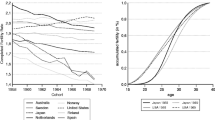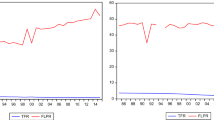Abstract
Various authors find that in OECD countries the cross-country correlation between the total fertility rate and the female labour force participation rate turned from a negative value before the 1980s to a positive value thereafter. Based on pooled cross-sectional data, Kögel (2004) shows that (a) unmeasured country-specific factors and (b) country-heterogeneity in the magnitude of the negative time-series association accounts for the reversal in the sign of the cross-country correlation coefficient. Our paper aims to identify those variables that may explain country heterogeneity in the negative association between fertility and female labour force participation. The selection of variables is based on existing macro-demographic theories. We apply aggregate descriptive representations of the time series and cross-country evolution of fertility, female employment and a set of labour market,educational and demographic variables and indicators of social policy.
Similar content being viewed by others
References
Adsera, A., 2004. 'Changing fertility rates in developed countries. The impact of labor market institutions'. Journal of Population Economics, forthcoming.
Ahn, N. and Mira, P., 2002. 'A note on the changing relationship between fertility and female employment rates in developed countries'. Journal of Population Economics 15: 667-682.
Andersson, G., 2001. 'The impact of labour-force participation on childbearing behavior: procyclical fertility in Sweden during the 1980s and the 1990s'. European Journal of Population 16: 293-333.
Apps, P. and Rees, R., 2001. Fertility, Female Labor Supply and Public Policy. IZA Discussion Paper No. 409. Bonn: Institute of the Study of Labor.
Barro, R. J. and Lee, J.-W., 2001. 'International data on educational attainment: updates and implications', Oxford Economic Papers 3: 541-563.
Becker, G. S., 1991. A Treatise on the Family, enl. ed. Cambridge, Mass.: Harvard University Press.
Benjamin, K., 2001. Men, Women, and Low Fertility: Analysis across Time and Country. Chapel Hill: University of North Carolina, Unpublished Manuscript.
Bettio, F. and Villa, P., 1998. 'A mediterranean perspective on the break-down of the relationship between participation and fertility'. Cambridge Journal of Economics 22: 137-171.
Billari, F. and Kohler, H.-P., 2002. Patterns of Lowest-low Fertility in Europe. MPIDRWorking Paper WP 2002-040. Rostock: Max Planck Institute for Demographic Research.
Brewster, K. L. and Rindfuss, R. R., 2000. 'Fertility and women's employment in industrialized nations'. Annual Review of Sociology 26: 271-296.
Butz, W. P. and Ward, M. P., 1979. 'The emergence of countercyclical US fertility'. American Economic Review 69: 318-328.
Castles, F. G., 2003, The World Turned Upside Down: Below Replacement Fertility, Changing Preferences and Family-friendly Public Policy in 21 OECD Countries. University of Edinburgh: Unpublished Manuscript.
Cigno, A., 1991. Economics of the Family. Oxford: Clarendon Press.
Council of Europe, 2001. Recent Demographic Developments in Europe. Strasbourg: Council of Europe Publishing.
de Laat, J. and Sevilla-Sanz, A., 2003. The Unequal Division of Household Labor: Gender Roles and the Puzzle of Positive Correlation between Fertility and Female Labor-force Participation. Brown University: Unpublished Manuscript.
de la Fuente, A. and Doménech, R., 2002. Educational Attainment in the OECD, 1960-1995. Instituto de Análisis Económico: Unpublished Manuscript.
Del Boca, D., 2002. The Effect of Childcare and Part Time Opportunities on Participation and Fertility Decisions in Italy. IZA Discussion Paper No. 427. Bonn: Institute of the Study of Labor.
DiPrete, T. A., Morgan, S. P., Engelhardt, H. and Pacalova, H., 2003. 'Do cross-national differences in the costs of children influence fertility behavior?'. Population Research and Policy Review, forthcoming.
Di Tommaso, M. L., 1999. 'A trivariate model of participation, fertility and wages: the Italian case'. Cambridge Journal of Economics 23: 623-640.
Easterlin, R. A., 1980. Birth and Fortune: The Impact of Numbers on Personal Welfare. New York: Basic Books.
Easterlin, R. A., 1987. 'Easterlin hypothesis', in J. Eatwell, M. Milgate and P. Newman (eds), The New Palgrave: A Dictionary to Economics 2. New York: The Stockton Press. pp. 1-4.
Engelhardt, H., Kögel, T. and Prskawetz, A., 2004. 'Fertility and women's employment reconsidered: a macro-level time series analysis for developed countries, 1960-2000'. Population Studies, forthcoming.
Engelhardt, H. and Prskawetz, A., 2002. On the Changing Correlation between Fertility and Female Employment over Space and Time. MPIDR Working Paper WP 2002-052. Rostock: Max Planck Institute for Demographic Research.
Ermisch, J., 1979. 'The relevance of the “Easterlin hypothesis” and the “New Home Economics” to fertility movements in Great Britain'. Population Studies 33: 39-58.
Esping-Andersen, G., 1999. Social Foundations of Postindustrial Economies. Oxford: Oxford University Press.
Galor, O. and Weil, D. N., 1996. 'The gender gap, fertility and growth'. American Economic Review 86: 374-387.
Gauthier, A. H., 1996. The State and the Family: A Comparative Analysis of Family Policies in Industrialized Countries. Oxford: Clarendon Press.
Gauthier, A. H., 2002. Comparative Family Benefits Database 1970-2000, Unpublished Database.
Gornick, J. C., Meyers, M. K. and Ross, K. E., 1997. 'Supporting the employment of mothers: policy variation across fourteen states'. Journal of European Social Policy 7: 45-70.
Gruber, J. and Wise, D. A., 1999. Social Security and Retirement Around The World. Chicago and London: The University of Chicago Press.
Heckman, J. J. and Walker, J. R., 1990. 'The relationship between wages and income and the timing and spacing of births: evidence from Swedish longitudinal data'. Econometrica 58: 1411-1441.
Henkens, K., Grift, Y. and Siegers, J., 2002. 'Changes in female labor supply in the Netherlands 1989-1998: the case of married and cohabiting women'. European Journal of Population 18: 39-57.
Hotz, V. J, Klerman, J. A. and Willis, R. J., 1997. 'The economics of fertility in developed countries', in M. R. Rosenzweig and O. Stark (eds), Handbook of Population and Family Economics. Amsterdam: Elsevier. pp. 275-347.
Huber, E., Ragin, C. and Stephens, J. D., 1997. Comparative Welfare Data Set. Online Available: http://lisweb.ceps.lu/publications/welfaredata/welfareaccess.htm.
Kögel, T., 2004. 'Did the association between fertility and female employment within OECD countries really change its sign?'. Journal of Population Economics, forthcoming.
Kravdal, Ø., 2002. 'The impact of individual and aggregate unemployment and fertility in Norway'. Demographic Research 6(10). Online www.demographic-research.org.
Macunovich, D. A., 1996. 'A review of recent developments in the economics of fertility', in P. Menchik (ed), Household and Family Economics. Kluwer: Academic Press. pp. 91-150.
OECD, 2001. Employment Outlook. Paris: Organization for Economic Cooperation and Development.
OECD, 2002. OECD Labor Force Statistics 1980-2000. Paris: Organization for Economic Cooperation and Development.
O'Reilly, J. and Fagan, C. (eds), 1998. Part-time Prospects. An International Comparison of Parttime Work in Europe, North America and the Pacific Rim. London, New York: Routledge.
Pampel, F. C., 2001. The Institutional Context of Population Change. Chicago: The University of Chicago Press.
Prskawetz, A., Vikat, A., Philipov, D. and Engelhardt, H., 2002. Pathways to Stepfamily Formation in Europe: Results from the FFS. MPIDR Working Paper WP 2002-046. Rostock: Max Planck Institute for Demographic Research.
Rindfuss, R. R. and Brewster, K. L., 1996. 'Childrearing and fertility'. Population and Development Review 22 (Supplement): 258-289.
Rindfuss, R. R., Benjamin Guzzo, K. and Morgan, S. P., 2003. 'The changing institutional context of low fertility'. Population Research and Policy Review, forthcoming.
Sanderson, W. C., 1976. 'On two schools of economics of fertility'. Population and Development Review 2: 469-477.
Willis, R. J., 1973. 'A new approach to the economic theory of fertility behavior'. Journal of Political Economy 81: S14-S64.
Author information
Authors and Affiliations
Rights and permissions
About this article
Cite this article
Engelhardt, H., Prskawetz, A. On the Changing Correlation Between Fertility and Female Employment over Space and Time. European Journal of Population 20, 35–62 (2004). https://doi.org/10.1023/B:EUJP.0000014543.95571.3b
Issue Date:
DOI: https://doi.org/10.1023/B:EUJP.0000014543.95571.3b




